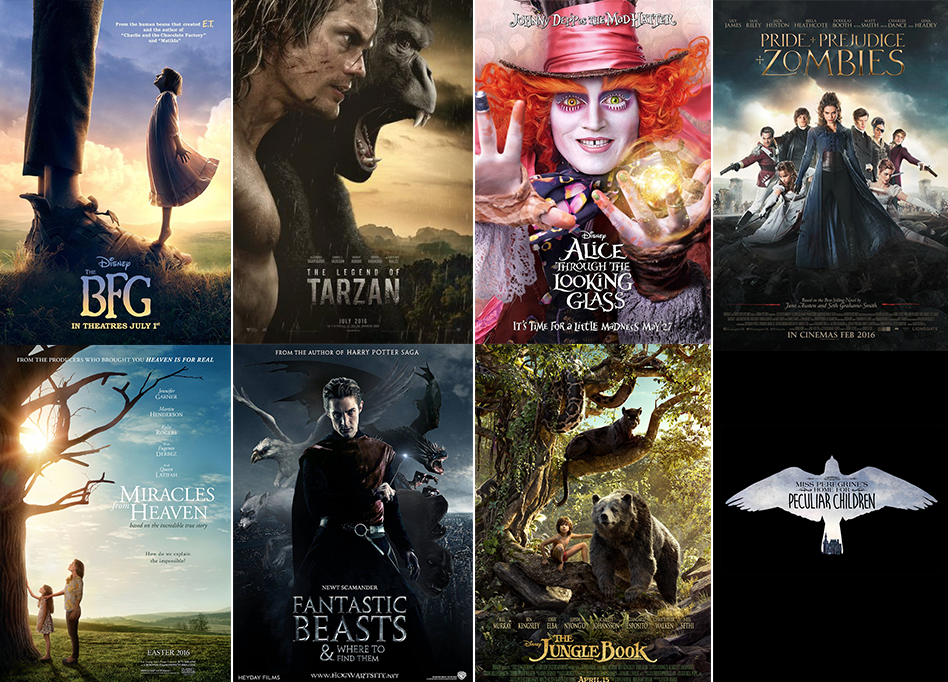Film adaptations have captivated audiences for decades, bringing beloved literature to life on the silver screen. Whether they are faithful recreations or creative reinterpretations, these movies based on books often spark lively debates about the merits of the original text versus the cinematic experience. Some of the best film adaptations manage to enhance their source material, offering fresh insights and interpretations that resonate with viewers. From classic novels to contemporary bestsellers, adapted literature can provide a rich tapestry of storytelling that inspires filmmakers in Hollywood and beyond. As Oscar season approaches, several critically acclaimed adaptations are competing for awards, reminding us of the powerful connection between literature and film.
Transforming written works into visual narratives is an art form in itself, often referred to as literary adaptations. These interpretations span various genres, from heartwarming family tales to thrilling mysteries, drawing inspiration from stories that have touched readers’ lives. Each movie represents a unique lens through which the narrative is reframed, allowing filmmakers to explore complex themes and character development in innovative ways. As audiences flock to theaters and streaming platforms, movies derived from novels offer an engaging way to experience literature afresh while stirring conversations about fidelity to the original story. With the continual evolution of storytelling techniques, adaptations remain an essential thread in the fabric of cinematic culture.
The Unique Charm of Film Adaptations: Bridging Literature and Cinema
Film adaptations have an uncanny ability to breathe new life into beloved literary works. When a novel transitions to the silver screen, it often undergoes significant transformations that challenge audiences to experience the story from a different perspective. Whether through the vivid visual representation of complex settings or the captivating performances of actors, adaptations can evoke a rich emotional response that the original text might not achieve. Notable examples include films like ‘The Shining’ and ‘Gone with the Wind,’ where the cinematic techniques employed enhance the storytelling, attracting new audiences to the source material and, in some cases, leading to renewed interest in the original books.
Additionally, the art of adaptation allows filmmakers to explore and reinterpret themes in ways that resonate within contemporary society. For instance, the adaptation of popular science fiction novels often addresses current global issues, bringing timeless narratives into the context of modern challenges. This dynamic has made many film adaptations not just simple retellings, but rather re-imaginings that speak to the audience’s societal experience. By analyzing and creatively transforming adapted literature, filmmakers can create compelling narratives that maintain the essence of the original while also allowing for innovative storytelling.
Exploring the Best Film Adaptations of Classic Novels
When discussing the best film adaptations, enthusiasts often cite works that successfully translate textual depth into cinematic experiences. For instance, adaptations like ‘Pride and Prejudice’ and ‘The Great Gatsby’ have garnered acclaim for their rich visuals and heartfelt performances, proving that not all adaptations simply strip away the core elements of the story. Instead, these adaptations often enhance the narrative by allowing directors to interpret characters and settings in ways that elevate the emotional impact. The ability to depict intricate relationships and the nuances of context makes film adaptations not only a visual feast but also a profound experience for viewers.
Moreover, the success of these adaptations hinges on careful casting and the cinematographical artistry that brings the author’s world to life. The iconic portrayal of Elizabeth Bennet in ‘Pride and Prejudice’ exemplifies how a strong performance can resonate with audiences, making characters relatable and memorable. As such, adaptations can introduce timeless classics to new generations, ensuring that the essence of the literature survives while evolving to meet contemporary tastes. This enduring value is particularly relevant as recent adaptations continue to reveal fresh perspectives, turning classics into relevant discussions in modern culture.
Reimagining Stories: Hollywood Adaptations That Redefine the Source Material
Hollywood has a long-standing relationship with adapted literature, often taking creative liberties to reinterpret narratives for a broader audience. Some adaptations, such as ‘The Shawshank Redemption’ and ‘Forrest Gump,’ manage not just to bring stories to life but also to expand upon the themes present in the original works. Filmmakers have the unique opportunity to exploit the strengths of the cinematic form, such as pacing, music, and visual storytelling, to enhance the plot and character arcs. This kind of reimagining can create a product that some argue is even more impactful than the initial text.
However, this practice can lead to polarized opinions among fans of the original works. While some appreciate the artistic vision that emerges through reinterpretation, others may feel that essential elements of the story are compromised. For instance, the adaptation of ‘The Golden Compass’ received mixed reviews from Steampunk enthusiasts for altering crucial plot points from the source material. This highlights the delicate balance that creators must strike between fidelity to the original text and the demands of cinematic storytelling, ultimately showcasing the dual nature of adapted literature in Hollywood.
The Complex Relationship Between Books and Their Film Adaptations
The relationship between books and their film adaptations is often characterized by a complex interplay of loyalty and creative freedom. Adaptations are tasked with the challenge of condensing the vast narratives of novels into a limited runtime while also capturing the essence of the characters and settings. This challenge often leads to important decisions about which subplots and details to retain or eliminate, which can significantly alter the audience’s perception of the story. For many fans of literature, the idea that ‘the book is better’ is frequently echoed, yet this notion can obscure the transformative potential of film.
Successful adaptations often spark discussions about thematic elements and character motivations that may have been overlooked in the original text. For instance, the film ‘Misery’ has been lauded for its faithful representation of Stephen King’s exploration of the nature of fame and success, despite some critics noting that the film version lacks the depth present in the novel. Such discussions ignite a fascinating dialogue about the merits of both mediums and point to the reality that not every adaptation sets out to replicate the source material but rather aims to offer a new lens through which to view a familiar story.
The Role of Actors in Bringing Adapted Literature to Life
Casting plays a pivotal role in the success of film adaptations, as the right actor can embody the essence of a character and significantly enhance the narrative. The performances of actors bring depth to the roles, allowing audiences to connect emotionally with the characters they portray. For instance, Kathy Bates’ Oscar-winning performance in ‘Misery’ not only captured the chilling essence of Annie Wilkes but also grounded the film in a way that resonated with viewers, allowing them to experience the suspense and horror in an immediate and impactful manner.
Actors are thus essential in bridging the gap between literature and cinema. Their interpretations can also lead to a fresh understanding of the characters and the themes presented in the original work. This is evidenced in films like ‘American Psycho,’ where Christian Bale’s portrayal added layers of complexity to the character that were perhaps less pronounced in Bret Easton Ellis’s novel. The alchemy of performance and storytelling shapes the viewing experience, emphasizing that film adaptations are as much about the art of acting as they are about faithfully retelling a beloved narrative.
The Impact of Screenwriting on Film Adaptations
Screenwriting is a crucial element in the process of adapting literature for the screen. A skilled screenwriter must capture the essence of the original story while also considering the storytelling techniques unique to film. This often involves restructuring the plot, modifying character arcs, and creating dialogue that suits the auditory experience of cinema. Screenwriters must work closely with directors to ensure that the adaptation resonates with both aficionados of the book and new audiences.
Moreover, the screenwriting process allows for creative liberties that can result in a narrative that feels distinctively cinematic. For instance, ‘L.A. Confidential’ stands as a hallmark of how effective screenwriting can transform a novel’s complex narrative into a gripping film that retains its core themes while appealing to a wider audience. Thus, the role of the screenwriter is not simply to translate text but to enrich the narrative, making it resonate in a vibrant and engaging way.
Cinematic Techniques That Enhance Adapted Literature
Cinematic techniques play a significant role in the effectiveness of film adaptations. From camera angles to sound design, filmmakers utilize various tools to create an emotional landscape that complements the narrative. For instance, in ‘Once Upon a Time in America,’ the use of sweeping landscapes and evocative music helps to convey the grandiosity and tragedy embedded in the story, transforming the narrative into a visual and auditory experience. These artistic choices can elevate a film’s storytelling beyond the written word, drawing viewers deeper into the narrative world.
Furthermore, visual storytelling allows for the creation of atmospheres that are not easily replicated in text form. The melancholic tones in ‘American Psycho’ offer an immersive experience that complements the film’s themes of excess and superficiality. The synergy of visuals and sound captures the emotional weight of the story more vividly than the written word alone. In essence, adept cinematic techniques enable adaptations to resonate with audiences on multiple levels, illustrating the distinction between adapted literature and its filmic counterpart.
The Critique of Film Adaptations: Analyzing the Transformation of Narratives
Film adaptations are often met with critique that stems from a deep love for the original literature. While some adaptations succeed in capturing the heart of the source material, others fall short, leading fans to voice dissatisfaction over liberties taken in interpretation. The debate centers around whether changes made for the screen serve to enhance or undermine the original narrative. In cases like ‘The Hobbit,’ where the film expanded on the source material, viewers were divided—some praised the creativity, while others longed for the concise storytelling of J.R.R. Tolkien’s prose.
This critique highlights the inherent challenges filmmakers face when translating literature to film. The necessity of brevity in storytelling often forces adaptations into a corner, where they must choose what to emphasize. As such, the conversation regarding adaptations becomes rich with differing viewpoints, as audiences grapple with their expectations and the realities of cinematic storytelling. This dialogue ultimately underscores the unique relationship between books and films and opens avenues for understanding how narratives can evolve across different mediums.
Why Film Adaptations Can Revitalize Literary Works
Film adaptations can serve as powerful vehicles for revitalizing literary works, introducing them to new generations who may not have engaged with the text otherwise. The visual medium often makes the themes and characters more relatable, inviting wider discussions around the source material. For instance, classics like ‘To Kill a Mockingbird’ have gained renewed critical attention following notable film adaptations, allowing for conversations about race, justice, and morality to form in contemporary contexts. By presenting literature in an accessible format, filmmakers can reignite interest in the written work and encourage audiences to explore the original text.
Additionally, the popularity of certain adaptations can drive sales of the corresponding books, as viewers seek to delve deeper into the source material. Such patterns highlight how the film industry can influence literary culture, fostering recognition for both established and emerging authors. Through the lens of adaptations, literature finds new life, and timeless narratives can remain relevant despite the passage of time, thus cultivating a cycle of appreciation for both reading and film.
Frequently Asked Questions
What makes a film adaptation better than the original book?
While many often say ‘the book was better’, some film adaptations effectively capture the essence of the original material while adding cinematic elements that enhance the story. Adaptations like ‘L.A. Confidential’ and ‘Misery’ offer compelling narratives, strong character development, and visual storytelling that can sometimes surpass the original book experience.
What are some of the best film adaptations of popular novels?
Some of the best film adaptations include ‘The Shawshank Redemption’, ‘The Godfather’, and ‘Pride and Prejudice’. Each of these films has been praised for staying true to the source material while also enriching the narrative visually and emotionally. They exemplify how adapted literature can resonate with both readers and viewers alike.
Are there any Hollywood adaptations that diverged significantly from their source material?
Yes, many Hollywood adaptations take creative liberties. For example, the film ‘American Psycho’ diverges from Bret Easton Ellis’ novel by adding humor and a lively narrative approach that differs from the book’s tone. These changes can bring new life to otherwise average books, showcasing the unique strengths of film as a medium.
How do adaptations influence the perception of literature?
Adaptations can significantly alter how we perceive the original literature. Films like ‘Once Upon a Time in America’ reshaped Harry Grey’s narrative by emphasizing visual storytelling and music over dialogue. This operatic approach can create new interpretations of themes and characters, thus influencing audience understandings of the source material.
What are the common challenges in adapting literature to film?
Adapting literature to film often presents challenges such as condensing complex plots, maintaining character depth, and translating literary themes to a visual medium. Films may simplify or alter storylines, leading to debates about fidelity to the original work. Adapting novels into films also requires reimagining narratives for pacing and audience engagement.
Which genres benefit most from book adaptations into movies?
Genres such as horror, mystery, and drama often see successful adaptations into film. Works like ‘Misery’ and the ‘Jack Reacher’ series capitalize on thrilling narratives and character arcs that lend themselves well to visual storytelling. Such adaptations can attract a large audience eager for cinematic interpretations of their favorite tales.
How does a successful film adaptation differ from a failure?
A successful film adaptation stays true to the heart of the story while offering new perspectives, whereas a failure often mismatches tone or neglects crucial character development. For instance, some beloved adaptations like ‘The Godfather’ resonate deeply with audiences, while others that stray too far from the source material, or fail to capture its essence, may fall flat.
What role do directors and screenwriters play in film adaptations of literature?
Directors and screenwriters are crucial in interpreting and transforming the original text into a visual narrative. Their creative choices shape how themes, characters, and plots are handled, impacting the final film’s tone and emotional depth. Great adaptations often result from their thoughtful collaboration in balancing respect for the source material with cinematic creativity.
Can a film adaptation capture the nuances of the original book?
While film adaptations may not always capture every nuance of the original book, the best adaptations effectively convey essential themes and character insights. For example, ‘Where Are You Going, Where Have You Been?’ allowed for deeper emotional exploration, transforming a short story into a captivating cinematic experience.
| Book | Author | Adaptation | Key Points |
|---|---|---|---|
| Misery | Stephen King | 1990 Film | Captures the essence of writing and fame, though some literary insights are lost. |
| L.A. Confidential | James Ellroy | 1997 Film | Great character development and atmosphere; captures the gritty essence of Hollywood. |
| Jack Reacher Series | Lee Child | Tom Cruise Films | The adaptations reflect Child’s storytelling techniques but amplify the melodrama. |
| The Hoods | Harry Grey | 1984 Film | The film adaptation transforms a basic narrative into an operatic masterpiece. |
| American Psycho | Bret Easton Ellis | 2000 Film | Adaptation adds rich humor and a lively narrative to an otherwise bleak story. |
| Where Are You Going, Where Have You Been? | Joyce Carol Oates | 1985 Film | Adaptation expands on character dynamics and nuances, enhancing emotional depth. |
Summary
Film adaptations present a fascinating twist on original literary works, often reshaping narratives while exploring deeper themes. While the adage “the book was better” frequently emerges in discussions surrounding adaptations, many films succeed not only in retelling stories but also in elucidating their underlying messages in innovative ways. As seen through various examples, adaptations can breathe new life into their source material, offering audiences a fresh perspective, enriching character dynamics, and even altering endings to create more engaging cinematic experiences.



